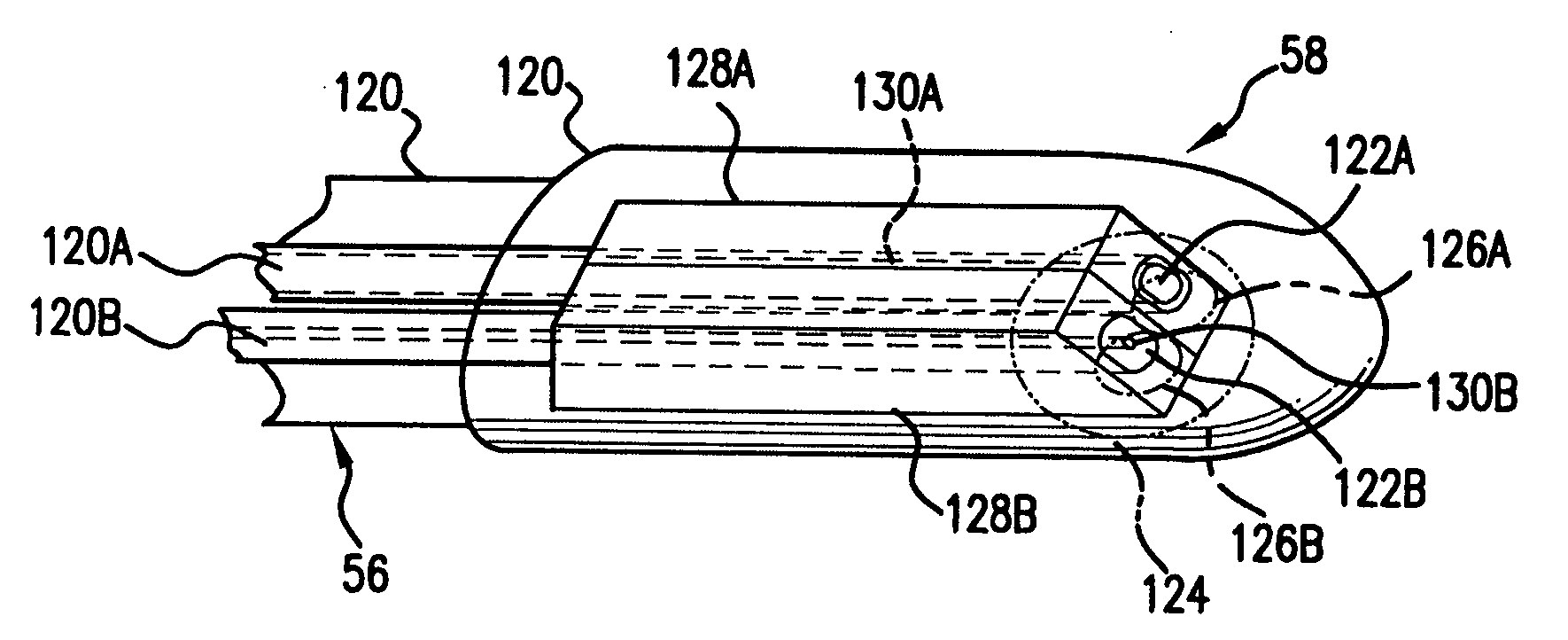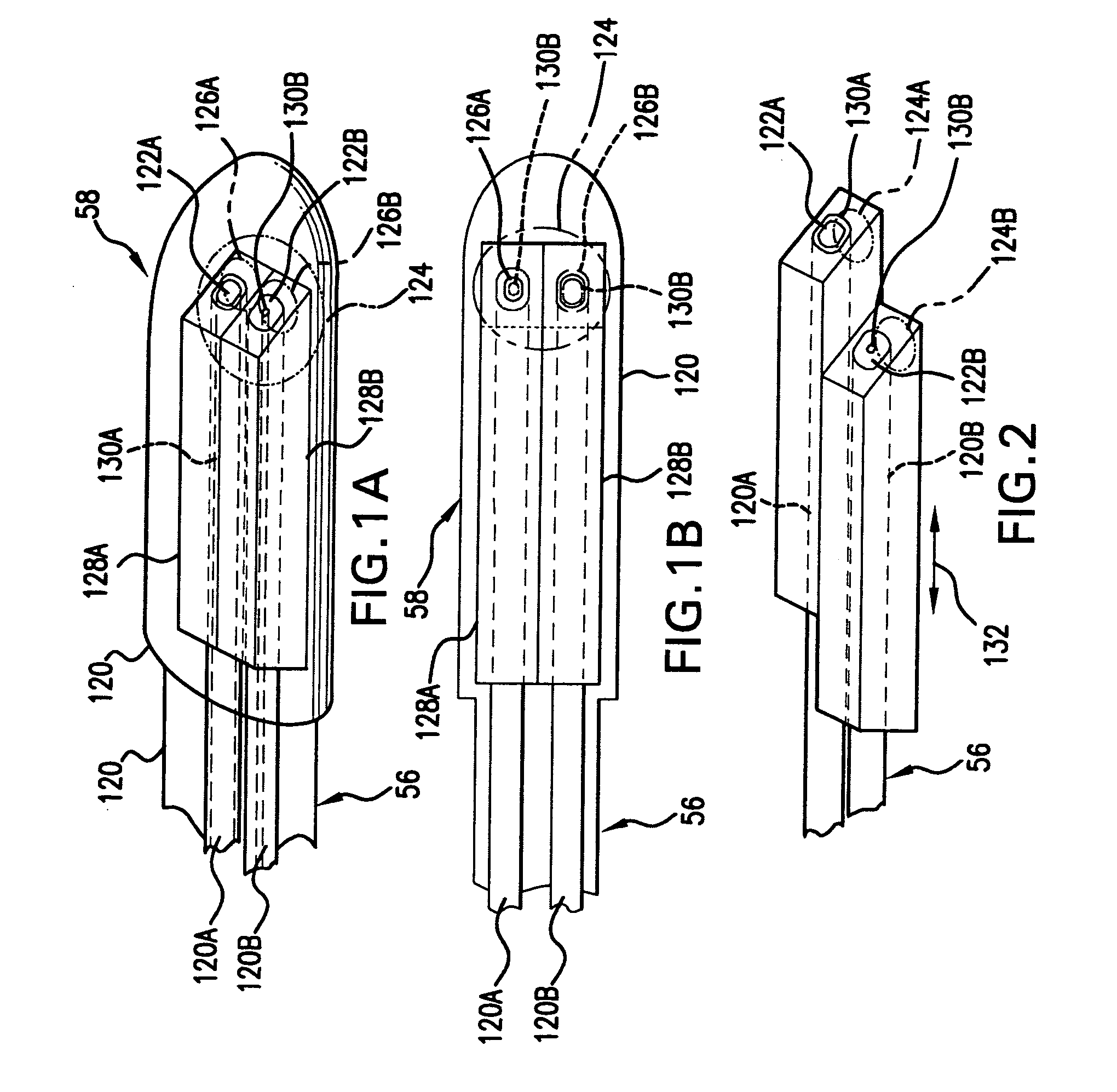Side firing fiber optic array probe
a fiber optic array and probe technology, applied in the field of side firing fiber optic array probes, can solve the problems of high manufacturing or assembly costs of these conventional side-firing probes, poor adaptability to multi-fiber probes, and time-consuming, and achieve the effect of easy assembly and easy adjustment of separation
- Summary
- Abstract
- Description
- Claims
- Application Information
AI Technical Summary
Benefits of technology
Problems solved by technology
Method used
Image
Examples
first embodiment
[0038] Multiple optical fibers extend through the catheter 56 to the catheter's head 58, within the casing 120. In this first embodiment, the two optical fibers 120A, 120B are provided. The terminal ends of these optical fibers 120A, 120B have side-firing terminations 122A, 122B. In one embodiment, these side-firing terminations 122A, 122B are coated to reflect light. In other examples, the index mismatch between the material of the optical fibers 120A, 120B and the medium adjacent to the side-firing terminations 122A, 122B, such as air, provides the required reflectivity. The side-firing terminations 122A, 122B, in effect, couple the optical fibers 120A, 120B to a region 124 that is lateral to the probe head 58.
[0039] Specifically, light emanating from the region 124 and directed radially with respect to an toward the fibers is reflected by the side-firing terminations 122A, 122B to be coupled into and propagated by the optical fibers 120A, 120B. Similarly, light propagating throug...
second embodiment
[0045]FIG. 2 shows the multi-fiber optic medical probe. In this example, the side-firing terminations 122A and 122B of optical fibers 120A and 120B, respectively, are longitudinally offset with respect to each other. The side-firing terminations are located at different positions along the longitudinal axis 132 of the catheter 56. As a result, the optical fiber 120A collects light from region 124A, whereas optical fiber 120B emits light into region 124B. This embodiment has the advantage of being able to control the position where the light is emitted and collected. It allows increases in the path length of light traveling from optical fiber 120B to 120A without substantially increases the width of the probe.
[0046] In the embodiments illustrated in FIGS. 1A, 1B, and 2, the manufacturing process for the multi-fiber optic medical probe is as follows. First, any coating or sheath on the optical fibers 120A, 120B is stripped. The optical fibers 120A, 120B are then slid or inserted into ...
third embodiment
[0051]FIG. 4 shows the multi-fiber optic medical probe. In this example, the four optical fibers 120A-128D are provided. Each has respective beam shaping apertures 126A-126D.
[0052] The advantage of the third embodiment is that multiple collection multimode optical fibers are provided. The multiple multi-mode fibers 126A, 126C, 126D are located at different longitudinal positions along the longitudinal axis 132 of the probe 56. This allows light emitted by the single mode optical fiber 120B to be collected at multiple distances by the multimode collection optical fibers 120A, 120C, 120D. This allows the spectral response to be collected from different pathlengths.
PUM
 Login to View More
Login to View More Abstract
Description
Claims
Application Information
 Login to View More
Login to View More - R&D
- Intellectual Property
- Life Sciences
- Materials
- Tech Scout
- Unparalleled Data Quality
- Higher Quality Content
- 60% Fewer Hallucinations
Browse by: Latest US Patents, China's latest patents, Technical Efficacy Thesaurus, Application Domain, Technology Topic, Popular Technical Reports.
© 2025 PatSnap. All rights reserved.Legal|Privacy policy|Modern Slavery Act Transparency Statement|Sitemap|About US| Contact US: help@patsnap.com



